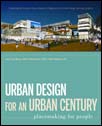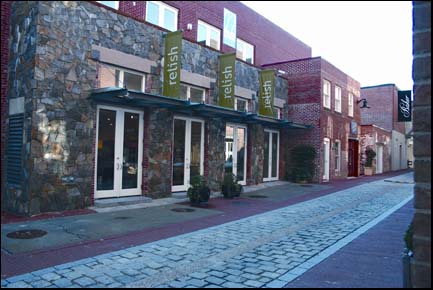Julia Galef reviews Urban Design for an Urban Century: Placemaking for People by Lance Jay Brown, David Dixon, and Oliver Gillham.
 Urban Design for an Urban Century: Placemaking for Peopleis really two books in one. The first half is a primer on how and why city forms have changed over time; nothing new, but it is accessible and engaging. The story starts in 2600 B.C. and sweeps breezily along, propelled by the forces of economics and technology, and by influential dictators, planners, and theorists. Knitting the narrative together are recurring patterns that carry different meanings each time they reappear: wide straight avenues, first implemented for military reasons and then to evoke grandeur in the City Beautiful era; or the grids that facilitated tax collection in medieval cities and, centuries later, expressed a young America's commitment to democratic principles.
Urban Design for an Urban Century: Placemaking for Peopleis really two books in one. The first half is a primer on how and why city forms have changed over time; nothing new, but it is accessible and engaging. The story starts in 2600 B.C. and sweeps breezily along, propelled by the forces of economics and technology, and by influential dictators, planners, and theorists. Knitting the narrative together are recurring patterns that carry different meanings each time they reappear: wide straight avenues, first implemented for military reasons and then to evoke grandeur in the City Beautiful era; or the grids that facilitated tax collection in medieval cities and, centuries later, expressed a young America's commitment to democratic principles.
The second half of the book is both more original and more problematic. The authors outline five principles of good urban design -- e.g., "Build community in an increasingly diverse society" and "Expand personal choices," -- and then illustrate them with 70 recent case studies. The principles are hard to argue with, but that's partly because they're vague enough to be verging on platitudinous. And with only a few paragraphs describing each project, the case studies are correspondingly vague as well.
But there are some interesting themes running through the 70 case studies, even if the authors don‘t highlight them. One in particular would have made for a fascinating discussion: the intricate balances that the featured designs strike between variety and uniformity. As plenty of the case studies demonstrate, visual unity between a project and its surroundings makes it feel like it belongs. And uniform design within a project can create a sense of place -- take, for instance, the master plan that lined Santa Monica Boulevard with a single species of tree to give it visual continuity.

Yet variety is also crucial to keep a new development from feeling monolithic and manufactured. That's why the developer of Cady's Alley in Washington, D.C. hired five different architects to design the block. (To tie the project together, they all collaborated on the design of the common spaces.) Other teams build variety into their project's design guidelines. The group that redeveloped 42nd street in Manhattan prohibited any "uniform or coordinated system among adjacent storefronts and signage," to prevent it from acquiring a "themed" feel in the future.
Striking the right balance between variety and uniformity is more than just an aesthetic issue; it's also a social one. Urban designers lessen the stigma of low-income housing developments by unifying them visually with their neighborhoods, and by creating aesthetic variety within a development to avoid the dreaded "housing project" feel. Within mixed-income developments like the Ellen Wilson community in D.C., a unified style avoids calling attention to differences between tenants' income levels. And mimicking pre-existing housing styles can even help spark revitalization. That's the strategy one team used for a development in a poor neighborhood of Louisville, KY: they gave prospective buyers the confidence to invest by "using the images and forms identified with successful, traditional Louisville neighborhoods," the team reports.
It's also disappointing that the authors don't use all those case studies to shed light on some of the controversies in the field. For example, they quote the editor of Urban Land Magazine, Kristina Kessler, articulating a common criticism of privately owned public spaces: that they prioritize consumerism and, "in their intent to attract an upscale clientele, these projects divide and exclude." Later, the authors praise the (largely privately owned) Ramsey Town Center in Minnesota for integrating offices, homes, entertainment, and three "public" spaces. So how does it avoid the pitfalls described by Ms. Kessler? The authors don't say.
But the biggest blind spot in the case studies is that they don't discuss how the projects are actually used. The book's subtitle is "placemaking for people," and successful places depend at least as much on good management and programming as they do on physical design. It's all too easy for projects to claim that they will be successful places, and all too hard to tell ahead of time which ones actually will. Without any examination of the outcomes of the case studies (many of which haven't even been built yet), too many of them read like the blurbs on the firms' own glossy promotional brochures.

Analysis: Cybertruck Fatality Rate Far Exceeds That of Ford Pinto
The Tesla Cybertruck was recalled seven times last year.

National Parks Layoffs Will Cause Communities to Lose Billions
Thousands of essential park workers were laid off this week, just before the busy spring break season.

Retro-silient?: America’s First “Eco-burb,” The Woodlands Turns 50
A master-planned community north of Houston offers lessons on green infrastructure and resilient design, but falls short of its founder’s lofty affordability and walkability goals.

Test News Post 1
This is a summary

Analysis: Cybertruck Fatality Rate Far Exceeds That of Ford Pinto
The Tesla Cybertruck was recalled seven times last year.

Test News Headline 46
Test for the image on the front page.
Urban Design for Planners 1: Software Tools
This six-course series explores essential urban design concepts using open source software and equips planners with the tools they need to participate fully in the urban design process.
Planning for Universal Design
Learn the tools for implementing Universal Design in planning regulations.
EMC Planning Group, Inc.
Planetizen
Planetizen
Mpact (formerly Rail~Volution)
Great Falls Development Authority, Inc.
HUDs Office of Policy Development and Research
NYU Wagner Graduate School of Public Service

























